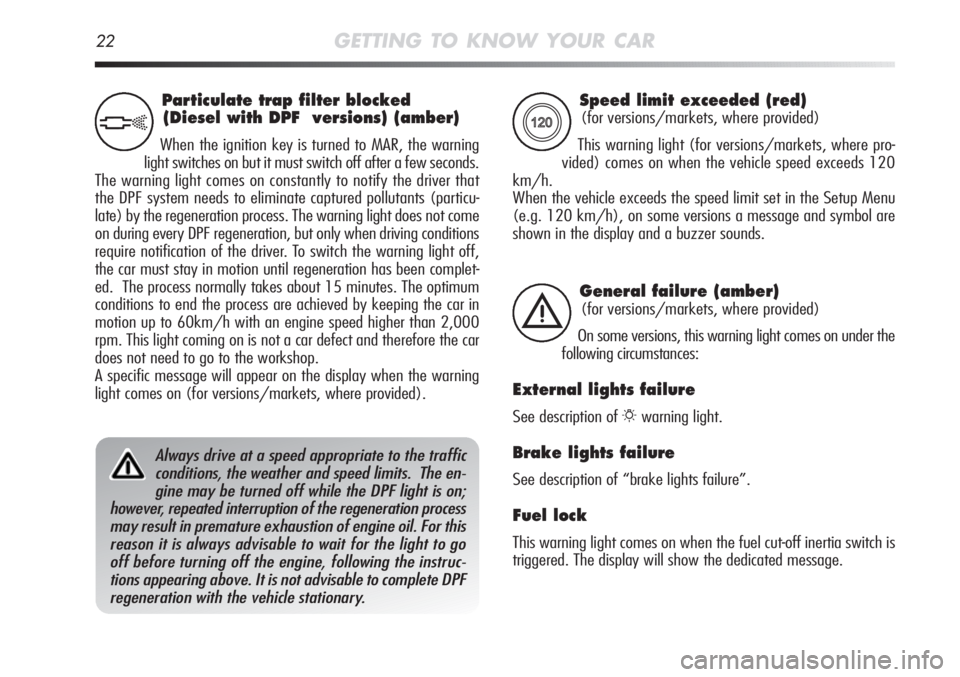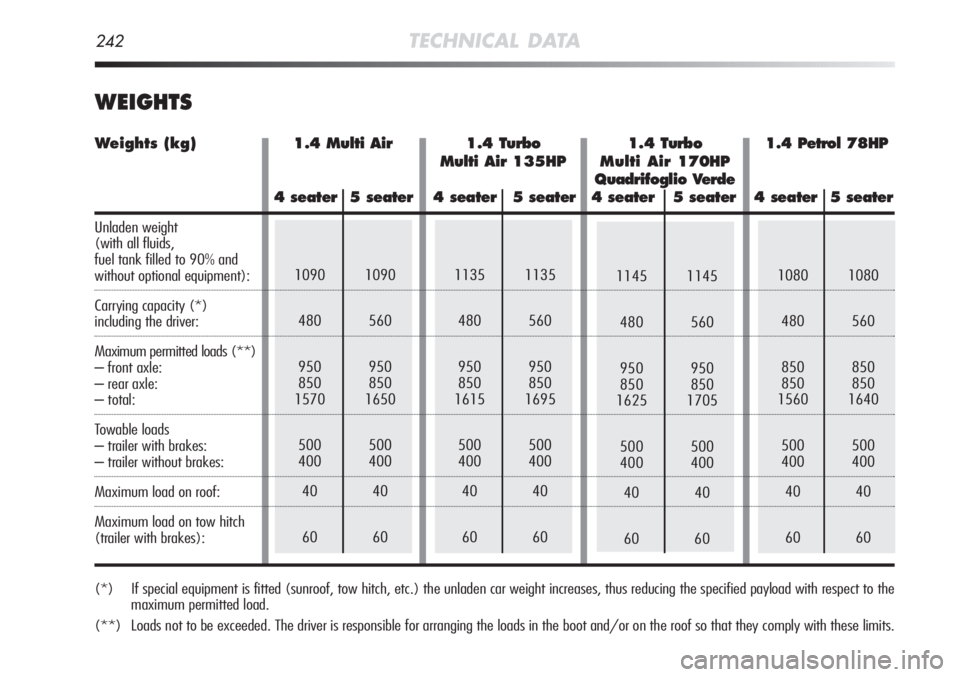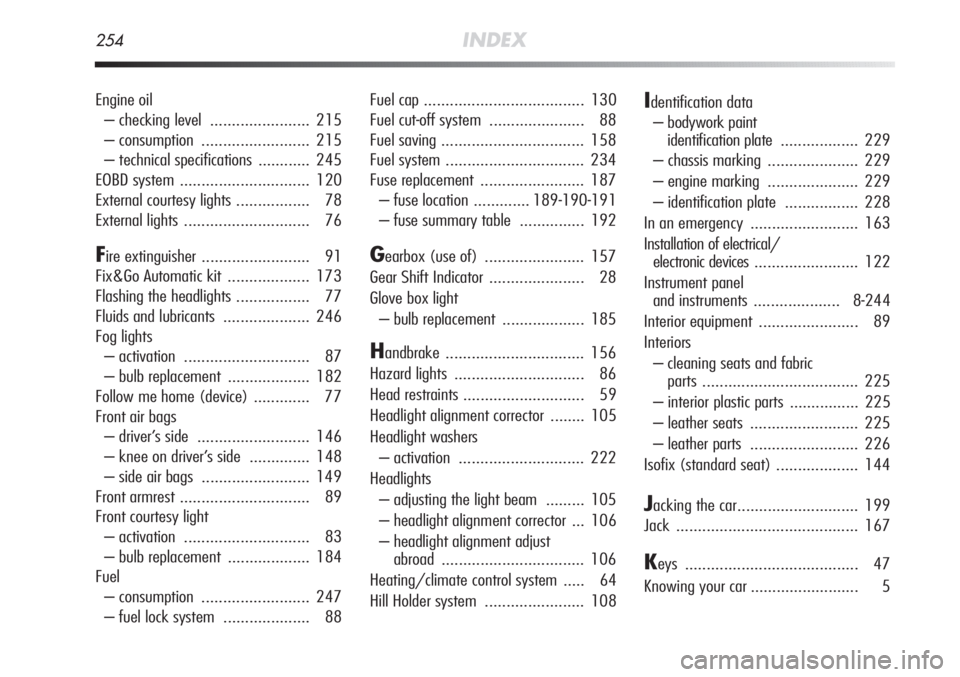fuel cap Alfa Romeo MiTo 2012 Owner handbook (in English)
[x] Cancel search | Manufacturer: ALFA ROMEO, Model Year: 2012, Model line: MiTo, Model: Alfa Romeo MiTo 2012Pages: 262, PDF Size: 6.46 MB
Page 23 of 262

22GETTING TO KNOW YOUR CAR
Speed limit exceeded (red)
(for versions/markets, where provided)
This warning light (for versions/markets, where pro-
vided) comes on when the vehicle speed exceeds 120
km/h.
When the vehicle exceeds the speed limit set in the Setup Menu
(e.g. 120 km/h), on some versions a message and symbol are
shown in the display and a buzzer sounds.
X
General failure (amber)
(for versions/markets, where provided)
On some versions, this warning light comes on under the
following circumstances:
External lights failure
See description of 6warning light.
Brake lights failure
See description of “brake lights failure”.
Fuel lock
This warning light comes on when the fuel cut-off inertia switch is
triggered. The display will show the dedicated message.
è
Particulate trap filter blocked
(Diesel with DPF versions) (amber)
When the ignition key is turned to MAR, the warning
light switches on but it must switch off after a few seconds.
The warning light comes on constantly to notify the driver that
the DPF system needs to eliminate captured pollutants (particu-
late) by the regeneration process. The warning light does not come
on during every DPF regeneration, but only when driving conditions
require notification of the driver. To switch the warning light off,
the car must stay in motion until regeneration has been complet-
ed. The process normally takes about 15 minutes. The optimum
conditions to end the process are achieved by keeping the car in
motion up to 60km/h with an engine speed higher than 2,000
rpm. This light coming on is not a car defect and therefore the car
does not need to go to the workshop.
A specific message will appear on the display when the warning
light comes on (for versions/markets, where provided).
h
Always drive at a speed appropriate to the traffic
conditions, the weather and speed limits. The en-
gine may be turned off while the DPF light is on;
however, repeated interruption of the regeneration process
may result in premature exhaustion of engine oil. For this
reason it is always advisable to wait for the light to go
off before turning off the engine, following the instruc-
tions appearing above. It is not advisable to complete DPF
regeneration with the vehicle stationary.
Page 49 of 262

48GETTING TO KNOW YOUR CAR
KEY WITHOUT REMOTE CONTROL
The metal insert A-fig.14 operates:
❍the ignition switch;
❍the door locks;
❍the opening and closing of the fuel cap.
fig. 14A0J0211mfig. 15A0J0072m
Press button B-fig. 15 only after moving the key
away from your body, especially your eyes, and
from objects which could get damaged (e.g. your
clothes). Do not leave the key unattended, because some-
one, a child especially, may accidentally press the button
while handling the key.
KEY WITH REMOTE CONTROL
(for versions/markets, where provided)
The metal insert A-fig.15 operates:
❍the ignition switch;
❍the door locks;
❍the opening and closing of the fuel cap.
Press button B to open/close the metal insert.
Page 130 of 262

GETTING TO KNOW YOUR CAR129
1AT THE FILLING STATION
Switch off the engine before refuelling.
PETROL ENGINES
Only use unleaded petrol. The petrol octane rating (RON) must not
be lower than 95.
In order to prevent damage to the catalytic converter never intro-
duce even the smallest amount of leaded petrol, even in the event
of an emergency.
DIESEL ENGINES
Only use diesel fuel compliant with European specification EN590.
The use of other products or mixtures may damage the engine
beyond repair and consequently invalidate the warranty.
Operation at low temperatures
If the outside temperature is very low, the diesel thickens due to
the formation of paraffin clots with consequent defective operation
of the fuel supply system. In order to avoid these problems, dif-
ferent types of diesel are distributed according to the season: sum-
mer type, winter type and arctic type (cold, mountain areas).
If refuelling with diesel fuel whose features are not suitable for
the temperature of use, it is advisable to mix TUTELA DIESEL ART
additive with the fuel, in the proportions shown on the container.
Pour the additive into the tank before the fuel.When using or parking the vehicle for a long time in the mountains
or cold areas, it is advisable to refuel using locally available fuel.
In this case, it is also advisable to keep the tank over 50% full.
FUEL FILLER CAP
Opening
1) Open the flap A-fig. 82 pulling it outwards, keep the cap B
still, insert the ignition key in the lock and turn it anti-clockwise.
2) Turn the cap anti-clockwise and extract it. The cap has a de-
vice C retaining it to the flap so it cannot be lost. When refilling,
attach the cap to the flap D.
fig. 82A0J0327m
Page 131 of 262

The catalytic converter and particulate filter (DPF)
reach very high temperatures during operation.
Do not park on grass, dry leaves, pine needles or
other flammable material: fire risk.
130GETTING TO KNOW YOUR CAR
Closing
1) Fit the cap (complete with key) and turn it clockwise until it
clicks once or more.
2) Turn the key clockwise and extract it, then close the flap.
The hermetic seal may cause a slight increase in pressure in the
tank. A suction noise when you release the cap is therefore entirely
normal.
PROTECTING THE ENVIRONMENT
The devices for limiting petrol engine emissions are: catalytic con-
verter, Lambda sensors and anti-evaporation system.
The devices for curtailing diesel engine emissions are the follow-
ing: oxidising catalytic converter, exhaust gas recirculation system
(E.G.R.) and particulate filter (DPF).
DIESEL PARTICULATE FILTER (DPF)
(for versions/markets, where provided)
This is a mechanical filter, fitted in the exhaust system, which al-
most completely eliminates carbon particle emissions.
Keep naked flames or lighted cigarettes away from
the fuel filler hole as there is a danger of fire. Do
not bend too close to the hole either so as not to
breathe in harmful vapours.
Page 161 of 262

160STARTING UP AND DRIVING
Acceleration
Sudden acceleration has a very negative effect on fuel consump-
tion and emissions: accelerate gradually and do not go over the
maximum torque ratio.
CONDITIONS OF USE
Cold starting
Short distances and frequent cold start-ups will prevent the en-
gine from reaching optimal running temperature. Consequently,
both fuel consumption (from +15 to +30% on an urban cycle )
and emissions will increase.
Traffic and road conditions
Rather high fuel consumption is caused by heavy traffic, for instance
when travelling in a queue with frequent use of low gears or in
cities with many traffic lights. Mountain and rough roads also have
a negative effect on fuel consumption.
Traffic hold-ups
During prolonged hold-ups (level crossings) the engine should be
switched off.
TOWING TRAILERS
IMPORTANT NOTES
The vehicle must be provided with a type-approved tow hook and
adequate electrical system to tow caravans or trailers. Installation
must be carried out by a specialist.
Install any specific and/or additional rear-view mirrors as specified
by law.
Remember that when towing a trailer, steep hills are harder to
climb, braking distances increase and overtaking takes longer de-
pending on the overall weight.
Engage a low gear when driving downhill, rather than constantly
using the brake.
The weight of the trailer reduces the load capacity of the vehicle
by the same amount. Consider the weight of the fully-laden vehi-
cle weight, including accessories and luggage, to make sure you
do not exceed the maximum towable weight (shown on the reg-
istration certificate).
Respect the speed limits specific to each country for vehicles tow-
ing trailers. In any event do not exceed 100 km/h.
Page 243 of 262

242TECHNICAL DATA
(*) If special equipment is fitted (sunroof, tow hitch, etc.) the unladen car weight increases, thus reducing the specified payload with respect to the
maximum permitted load.
(**) Loads not to be exceeded. The driver is responsible for arranging the loads in the boot and/or on the roof so that they comply with these limits.
1135 1135
480 560
950 950
850 850
1615 1695
500 500
400 400
40 40
60 601090 1090
480 560
950 950
850 850
1570 1650
500 500
400 400
40 40
60 601080 1080
480 560
850 850
850 850
1560 1640
500 500
400 400
40 40
60 601145 1145
480 560
950 950
850 850
1625 1705
500 500
400 400
40 40
60 60
WEIGHTS
Weights (kg) 1.4 Multi Air 1.4 Turbo 1.4 Turbo 1.4 Petrol 78HP
Multi Air 135HPMulti A ir 170HP
Quadrifoglio Verde
4 seater 5 seater 4 seater 5 seater 4 seater 5 seater 4 seater 5 seater
Unladen weight
(with all fluids,
fuel tank filled to 90% and
without optional equipment):
Carrying capacity (*)
including the driver:
Maximum permitted loads (**)
– front axle:
– rear axle:
– total:
Towable loads
– trailer with brakes:
– trailer without brakes:
Maximum load on roof:
Maximum load on tow hitch
(trailer with brakes):
Page 244 of 262

TECHNICAL DATA243
6
1080 1080
480 560
850 850
850 850
1560 1640
500 500
400 400
40 40
60 601145 1145
480 560
950 950
850 850
1625 1705
500 500
400 400
40 40
60 601205 1205
480 560
1000 1000
850 850
1685 1765
1000 1000
400 400
40 40
60 601150 1150
480 560
950 950
850 850
1630 1710
1000 1000
400 400
40 40
60 60
(*) If special equipment is fitted (sunroof, tow hitch, etc.) the unladen car weight increases, thus reducing the specified payload with respect to the
maximum permitted load.
(**) Loads not to be exceeded. The driver is responsible for arranging the loads in the boot and/or on the roof so that they comply with these limits.
Pesi (kg) 1.4 Petrol 95HP 1.4 Turbo Petrol1.3 JTDM-21.6 JTDM
4 seater 5 seater 4 seater 5 seater 4 seater 5 seater 4 seater 5 seater
Unladen weight
fuel tank filled to 90% and
without optional equipment):
Carrying capacity (*) including
the driver:
Maximum permitted loads (**)
– front axle:
– rear axle:
– total:
Towable loads
– trailer with brakes:
– trailer without brakes:
Maximum load on roof
Maximum load on tow hitch
(trailer with brakes):
Page 253 of 262

Oil change? The experts recommend Selenia
The engine of your car is factory filled with Selenia.
This is an engine oil range which satisfies the most advanced
international specifications. Its superior technical characteristics
allowSelenia to guarantee the highest performance
and protection of your engine.
The Selenia range includes a number of technologically advanced products:
SELENIA SPORT
Fully synthetic lubricant capable of meeting the needs of
high performance engines.
Studied to protect the engine also in high thermal stress
conditions, it prevents deposits on the turbine to achieve
the utmost performance in total safety.
SELENIA WR PURE ENERGY
Fully synthetic lubricant that can meet the requirements of
the latest diesel engines.
Low ash content to protect the particulate filter from the
residual products of combustion. High Fuel Economy
System that allows considerable fuel saving.
It reduces the danger of dirtying the turbine to ensure the
protection of increasingly high performance diesel
enginesSELENIA StAR PURE ENERGY
Synthetic lubricant designed for petrol engines that need
products with a low ash content. It maximises the
characteristics of engines with high specific power,
protects the parts mostly subjected to stress and helps
to keep modern catalysts clean.
SELENIA RACING
This lubricant has been developed as a result of Selenia’s
extensive experience in track and rally competitions,
it maximises engine performance in all kinds of
competition use.
The range also includes K Pure Energy, Selenia Digitech,
Selenia Multipower, Selenia 20K, Selenia 20K AR.
For further information on Selenia products visit the web
sitewww.selenia.com
Page 254 of 262

INDEX253
7
Car maintenance......................... 201
– Heavy-duty use of the car ........ 207
– service schedule ..................... 202
Carrying children safely
– Isofix universal child
restraint system ..................... 143
– child seats ............................ 141
Car radio (wiring) ........................ 121
CBC system ................................ 110
Chassis marking .......................... 229
Checking fluid levels .................... 208
Cigar lighter................................ 90
Climatic comfort .......................... 63
CO
2emissions ............................ 249
CODE card .................................. 47
Compliance for use ...................... 141
Control buttons ........................... 29
Controls
– door lock.............................. 87
– front fog lights ....................... 87
– fuel cut-off system ................. 88
– hazard warning lights ............. 86
– rear fog lights ........................ 87
Courtesy lights ........................ 83-86
Courtesy mirror lights
– bulb replacement ................... 186
Cruise Control ............................. 81
Current outlet ............................. 90
ABS (system) ........................... 107
Air cleaner.................................. 217
Alarm ........................................ 53
Alfa “DNA” (system) ................... 111
Alfa Romeo CODE (system) .......... 46
Ashtray ...................................... 91
ASR system ................................ 109
At the filling station ...................... 129
Automatic two-zone climate
control system .......................... 68
Battery
– tips for extending duration ....... 217
– recharging............................ 196
– replacing .............................. 217
Bodywork (cleaning)................... 223
Bonnet ...................................... 103
Boot .......................................... 88
Boot light
– bulb replacement ................... 184
Brake lights ................................ 182
Brakes ....................................... 235
Bulb (replacement) ..................... 178
– general instructions ................ 178
– bulb types ............................ 178
Bulb replacement....................178-184
Capacities ................................. 128
– table capacities .................244-245
Dashboard............................ 7-243
Daylight lights (D.R.L.) ................. 76
Demanding use of the car ............. 207
Devices ...................................... 120
Dimensions ................................ 240
Dipped beam headlights
– activation............................. 76
– bulb replacement ................... 181
Direction indicators
– activation............................. 77
– replacement.......................... 182
Display ...................................... 26
Dynamic Suspension..................... 119
Door lock device .......................... 87
Doors ........................................ 95
DPF ........................................... 130
D.R.L. (daylight lights) ................. 76
DST system ................................ 110
Electric power steering system ...... 119
Electric sunroof ............................ 92
Electronic Q2 (“E-Q2”) ................ 110
Engine
– marking ............................... 229
– specifications ......................... 231
Engine codes
– bodywork versions ................. 230
Engine compartment (washing) ..... 223
Page 255 of 262

254INDEX
Engine oil
– checking level ....................... 215
– consumption......................... 215
– technical specifications ............245
EOBD system .............................. 120
External courtesy lights ................. 78
External lights ............................. 76
Fire extinguisher ......................... 91
Fix&Go Automatic kit ................... 173
Flashing the headlights ................. 77
Fluids and lubricants .................... 246
Fog lights
– activation............................. 87
– bulb replacement ................... 182
Follow me home (device) ............. 77
Front air bags
– driver’s side .......................... 146
– knee on driver’s side .............. 148
– side air bags ......................... 149
Front armrest .............................. 89
Front courtesy light
– activation............................. 83
– bulb replacement ................... 184
Fuel
– consumption......................... 247
– fuel lock system .................... 88Fuel cap ..................................... 130
Fuel cut-off system ...................... 88
Fuel saving ................................. 158
Fuel system ................................ 234
Fuse replacement........................ 187
– fuse location .............189-190-191
– fuse summary table ............... 192Gearbox (use of)....................... 157
Gear Shift Indicator ...................... 28
Glove box light
– bulb replacement ................... 185
Handbrake ................................ 156
Hazard lights .............................. 86
Head restraints ............................ 59
Headlight alignment corrector ........ 105
Headlight washers
– activation............................. 222
Headlights
– adjusting the light beam ......... 105
– headlight alignment corrector ... 106
– headlight alignment adjust
abroad ................................. 106
Heating/climate control system ..... 64
Hill Holder system ....................... 108
Identification data
– bodywork paint
identification plate .................. 229
– chassis marking ..................... 229
– engine marking ..................... 229
– identification plate ................. 228
In an emergency ......................... 163
Installation of electrical/
electronic devices........................ 122
Instrument panel
and instruments .................... 8-244
Interior equipment....................... 89
Interiors
– cleaning seats and fabric
parts .................................... 225
– interior plastic parts ................ 225
– leather seats......................... 225
– leather parts ......................... 226
Isofix (standard seat) ................... 144
Jacking the car............................ 199
Jack .......................................... 167
Keys ........................................ 47
Knowing your car ......................... 5